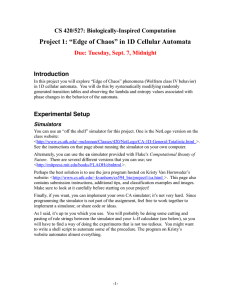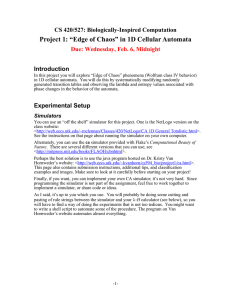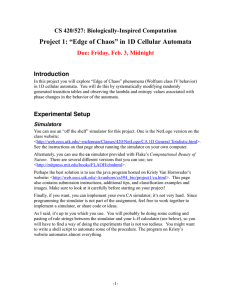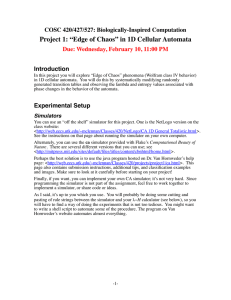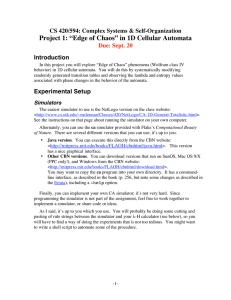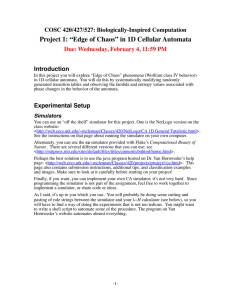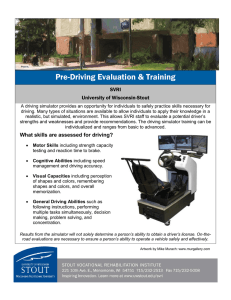a CS 420/594: Biologically-Inspired Computation Introduction Due: Sept. 11
advertisement
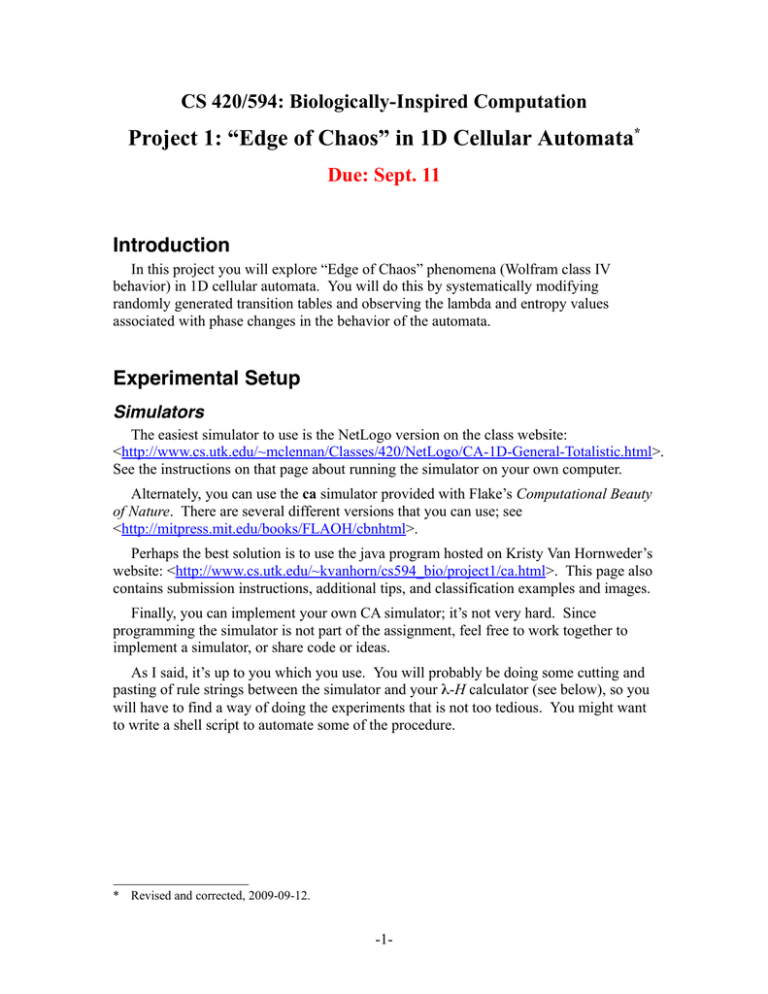
CS 420/594: Biologically-Inspired Computation
Project 1: “Edge of Chaos” in 1D Cellular Automata*
Due: Sept. 11
Introduction
In this project you will explore “Edge of Chaos” phenomena (Wolfram class IV
behavior) in 1D cellular automata. You will do this by systematically modifying
randomly generated transition tables and observing the lambda and entropy values
associated with phase changes in the behavior of the automata.
Experimental Setup
Simulators
The easiest simulator to use is the NetLogo version on the class website:
<http://www.cs.utk.edu/~mclennan/Classes/420/NetLogo/CA-1D-General-Totalistic.html>.
See the instructions on that page about running the simulator on your own computer.
Alternately, you can use the ca simulator provided with Flake’s Computational Beauty
of Nature. There are several different versions that you can use; see
<http://mitpress.mit.edu/books/FLAOH/cbnhtml>.
Perhaps the best solution is to use the java program hosted on Kristy Van Hornweder’s
website: <http://www.cs.utk.edu/~kvanhorn/cs594_bio/project1/ca.html>. This page also
contains submission instructions, additional tips, and classification examples and images.
Finally, you can implement your own CA simulator; it’s not very hard. Since
programming the simulator is not part of the assignment, feel free to work together to
implement a simulator, or share code or ideas.
As I said, it’s up to you which you use. You will probably be doing some cutting and
pasting of rule strings between the simulator and your λ-H calculator (see below), so you
will have to find a way of doing the experiments that is not too tedious. You might want
to write a shell script to automate some of the procedure.
* Revised and corrected, 2009-09-12.
-1-
Table-walk-through Procedure
As explained in class, we cannot simply allow the simulator to pick a random rule
string with a certain λ value, since there is too much variability between unrelated rule
strings. Therefore we will use Chris Langton’s table-walk-through method, which
involves generating a series of rule strings differing only in the number of quiescent
entries. The following describes an operational procedure.
Pick a random seed and record it. See the last page of this handout for a form that you
can use for recording your experiments (or invent your own spreadsheet); for your
convenience, a blank form is available online:
<http://www.cs.utk.edu/~mclennan/Classes/420/handouts/Experiment-Record-1.doc>.
Each experiment is conducted on a random rule string. The easiest way to get this is
to have your simulator generate one (use the button in the NetLogo simulator, or set
lambda=1.0 in the ca simulator). (You can also generate one yourself by picking 12
random integers in the range 1 to 4, since we exclude the quiescent state; the first number
is always 0, giving 13 all together.) Make sure to record your random rule string.
You will now decimate your rule string by zeroing one non-zero entry at a time. For
your original rule string and for each of the decimated rule strings you will compute a
λ λT H and HT value. Whether you compute them as you go along or do them all at the
end is up to you; which is easier will probably depend on the cutting-and-pasting or other
experimental procedure that you have selected. Note that the NetLogo simulator
computes them for you. You will also observe and record the behavior (I, II, III, or IV)
of the original string and each of its decimations.
For each decimation, randomly select one of the non-zero entries in the rule string and
set it to zero. Observe the behavior of the resulting CA and record it. Note: if you are
using the Java version of the ca simulator, make sure you set lambda=-1 (or any
negative value) before you enter your decimated string, or it will ignore your string and
regenerate the undecimated string! If you are using the NetLogo simulator, just press the
Decimate button.
I think you should do at least 20 table walk-throughs to have meaningful statistics.
However, you can do more, and better investigations will earn higher grades.
-2-
Lambda and Entropy Calculations
You will be investigating lambda and entropy values computed in two different ways.
(The NetLogo simulator computes these for you, but you still need to understand what
they mean.) The simplest way gives the totalistic parameters λ T and H T , which are
based on how frequently each state appears in the totalistic rule table (that is, the rule
string that you have recorded). The minimum sum of the neighborhood states is 0 and
the maximum is N K −1 , where K is the number of states and N =2r1 is the size of
the neighborhood for radius r. Therefore the size of the totalistic table is
S= N K−1 1 . In your case r = 1 and K = 5, so S = 13. Let R be the rule table so
that R k gives the new state for the sum k of the neighborhood states. We are interested
in the distribution of new-state values, so let m s Rk | Rk s , that is, m s is the
number of table entries that map into new state s. The totalistic lambda value λ T is
simply the fraction of totalistic rule table entries that do not map into the quiescent state
s = 0:
S −m 0
m
λT=
=1− 0
S
S
The entropy of the totalistic rule table is a function of its probability distribution.
Therefore let p s=ms /S so that the entropy H T of the totalistic transition table is
defined:
H T =−∑ p s lg p s ,
s
where lg x is the logarithm of x to the base 2. (Note that 0 lg 0=0 , which you will
have to handle as a special case since lg 0=−∞ .)
To facilitate comparison with non-totalistic CAs, the λ and H values are usually
defined over the complete (non-totalistic) transition table, which has T = K N entries.
However, we have an abbreviated rule table, of length N K −1 1 , which gives the
new state R k for a sum k; in most cases there are multiple configurations having the
same sum.
Therefore, let Ck be the number of neighborhood configurations having the sum k. For
K = 5 and r = 1, Ck is given by the following table:
k
Ck
0
1
1
3
2
6
3
10
4
15
5
18
6
19
7
18
8
15
9
10
10
6
11
3
Define n s to be the number of configurations leading to state s:
ns=
∑
{ k∣R k= s }
Ck
.
That is, n s is the total number of configurations that are mapped into state s by the
corresponding non-totalistic rule table. The probability of a new state in the complete
-3-
12
1
transition table is given by p s=n s /T . (Note: these p s are different from the p s
defined above for H T !) Then Langton’s λ is defined:
λ=
T −n0
n
=1− 0 =1− p 0 .
T
T
The entropy H of the complete transition table is defined:
H =−∑ p s lg p s .
s
Since you will be computing the λ λT H and HT values for each rule table, you will
have to use a program to do it. This is not an important part of the project, so you can do
it in any way convenient. You can implement your own program, or several (or all) of
you can get together and share a program. Also, some versions of the ca program will
compute λ (but not λT H and HT) for you.
Additional Work for CS 594 Students
If you are taking this course for graduate credit (CS 594), in addition to the foregoing
four parameters, you will need to compute a fifth parameter for the rules you test. But
you get to pick or design the parameter. So think about what property of the transition
tables might be correlated with the behavior class of a CA and figure out a way to
compute it. Your writeup (see below) should include a short (one paragraph) motivation
for your parameter (i.e., what makes you think that it might be correlated with behavior)
and a description of its computation. Your parameter might not turn out to be very good,
but that doesn’t matter; the point is to make a reasonable conjecture and to test it. In your
writeup, evaluate your new parameter in the same ways you do the others (λ λT H HT).
Students taking this course for undergraduate credit (CS 420) can also do this part,
which will earn you extra credit.
Writeup
Calculations
Compute the average and standard deviation of the λ λT H and HT values for all
simulation instances that exhibit class IV behavior. Which (λ λT H or HT) seems to be a
more reliable indicator of class IV behavior?
Graphs
Make four graphs of behavior vs. λ λT H and HT. That is, use λ λT H and HT for
the abscissas (x-axes) of the four graphs. (CS 594 students should, in addition, make
graphs of their fifth parameter.) For the ordinates (y-axes) of the graphs, use the
following numerical values to indicate qualitative behavior: 0 for classes I and II, 1 for
class IV, and 2 for class III. Each of your graphs should show all of your experiments as
separate curves; try to use colors or other ways of making the curves distinguishable.
-4-
Discussion
Draw some conclusions about the range of values of λ λT H and HT that lead to class
IV behavior. Note any anomalies. Did you ever observe class I or II behavior at high
λ λT H or HT values? Did you ever observe complex (IV) or chaotic (III) behavior at λ
λT H and HT values that were otherwise in the simple (I, II) region? How do you explain
these anomalies?
Extra Credit
The table above for the number of configurations is given by C k =D k , 3 , where
D k , N is the number of states, each in the range 0 to K −1 , arranged in a
neighborhood of size N, so that the states add up to k. (In other words, the number of
N
solutions to ∑ X i=k , where 0≤ X i ≤K −1 .) It can be computed by the following
i=1
equations:
{
k K
k ≥K
D k ,1 = 1,
0,
,
For n1 :
D k , n = nk −1 ,
k
k K .
K −1
D k , n = ∑ D k − j , n−1 ,
k ≥K .
j =0
I will give extra credit to anyone who can find a significantly simpler formula for D and
prove it is correct.
-5-
Experiment Record: 1D CA “Edge of Chaos”
Your Name: Bruce MacLennan .
simulator: [] NetLogo, NetLogo applet,
CBN: java, unix, mac, windows, other: ______________
K (states) = 5.
r (radius) = 1
wrap: []
quiescence: []
random seed = 1234567 .
1 .
Experiment Number:
Random Rule Table:
0
0
2
1
1
2
2
3
1
4
4
5
2
6
4
7
1
8
1
9
1
10
1
11
1
12
Table Walk-through:
Step
0
1
2
3
4
5
6
7
8
9
10
11
12
Entry
Zeroed
—
1
4
8
9
3
5
10
2
11
6
12
7
Class
III
III
IV
I
I
I
I
I
I
I
I
I
I
λ
H
λT
0.992 0.923 1.595
0.968 0.846 1.684
0.848 0.769 1.947
0.728 0.692 1.988
0.648 0.615 1.916
0.568 0.538 1.833
0.424 0.462 1.654
0.376 0.385 1.532
0.328 0.308 1.360
0.304 0.231 1.235
0.152 0.154 0.660
0.144 0.077 0.595
0
0
0
-6-
HT
1.669
1.727
1.834
1.884
1.884
1.738
1.573
1.489
1.352
1.145
0.773
0.391
0
Observations
Complex pattern , near IV
Same
near III
Very long IV transient
ditto
dies very quickly from here on down
